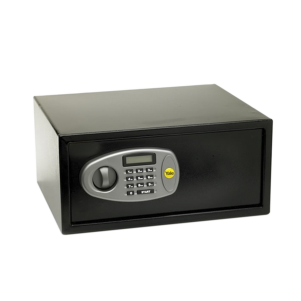Freestanding safes - pros, cons & installation tips
Security of your home or business should be a number one priority, and many people opt for a safe as a secure means of protecting valuable items. In a home this might be cash, jewellery, passports and legal documents such as property deeds and a will, while in a business this could be laptops, petty cash, personal data or confidential information such as contracts, product specs or trademark details.
Whatever you are needing to secure, and whether it has financial value or personal/commercial value, you need to find a safe that is suitable and practical for your needs. Many people opt for a freestanding safe as one of the most popular models available, but what is a freestanding safe? What are the pros and cons and what are the considerations you need to be aware of?
What is a freestanding safe?
A freestanding safe is made from robust, heavy plate steel much like any safe is, and it has a hinged door that can be opened using a security access means of your choice. This can be a traditional key, but is usually via a keypad and a unique four-digit code, or a biometric feature. A freestanding safe can be various sizes to suit your needs, but the main feature of a freestanding safe is that it is simply located on the floor and is not concealed in a wall or floor access, or in a cupboard, like other styles of safe. As we will study here, this has advantages and disadvantages in terms of security.
The pros and cons of freestanding safes
Pros
- Affordable – A freestanding safe is generally more affordable because it doesn’t require a specialist design to enable it to be built into a floor or wall recess, or to be concealed in a cupboard. It is fundamentally a much more simple design.
- Portable – A freestanding safe is often very heavy, let us make that very clear, and you wouldn’t want to be moving it around regularly, but it can be moved. And hence, if you moved house or moved business premises, for example, you could take the safe with you. Alternatively, a floor safe is concreted into a solid floor cavity and is essentially there forever. For this reason, freestanding safes are also popular with people who rent properties, because they can take the safe with them and it is not integral to the property.
- Options – With a freestanding safe you have options to move it from room to room or to different locations within a room, if you redesign a property or reconsider security risks.
- Fire and flood protection – A freestanding safe offers the same fire and flood protection as any other safe.
- Security – A freestanding safe is strong and tough and can’t be tampered with. You can choose your own access method and you can control who is authorised to access the safe.
- Insurance – You can select a safe with an insurance rating that is suitable for what you have stored inside it. You need to ensure you satisfy insurance requirements in order for your policy to be valid, so make sure the insurance rating is sufficient.
Cons
- Security risk – A freestanding safe is very heavy but technically can be picked up and removed from a property by an opportunist thief. However, they would still need a method of accessing the safe away from your property, and may opt for destructive methods. So even if they never accessed the safe and your belongings, you won’t be seeing the safe again. The weight of the safe does mitigate this risk, and it can also be bolted to the floor or wall, so it is likely that an intruder wouldn’t have the time, tools or skills to unbolt the safe and then remove it from your property in the time available or without alerting someone.
- Concealment – Because the safe is freestanding, it is visible in a room and can’t be concealed in a wall or floor recess. It is possible to cover the safe with items or to position it behind a desk or set of drawers, or you could try to locate it in a less obvious room, ie. a room an intruder wouldn’t immediately look in. Often an intruder doesn’t want to spend any more time in a property than is necessary, so delaying them by storing a safe in a less obvious room (a guest bedroom, a utility room or a small office, for example) could make a crucial difference.
- Size – A freestanding safe can be small, medium or large to suit your needs. Whatever size it is, storing it on the floor can become an obstacle and a safety hazard, so you need to consider this when finding a suitable location.
Installation tips for a freestanding safe
Most freestanding safes will be supplied with bolt holes through which you can secure the safe with anchor bolts. These would ideally be into a concrete wall or floor, but can be bolted into stud wall sections or to floor joists. This means an intruder can’t immediately pick the safe up and remove it. And while this physically secures the safe for your security purposes, it doesn’t prevent you unbolting the safe at some point if you need to move its location, or when you vacate the property.
Order your freestanding safe from MB Direct
You can check out our range of safes at MB Direct, including the freestanding safe, and order online today.